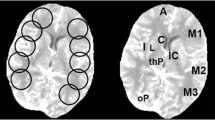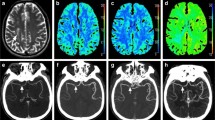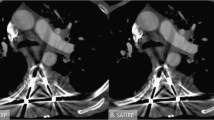Abstract
Introduction
Utilizing CT angiography enhances image quality in PCT, thereby permitting acquisition at ultra-low dose.
Methods
Dynamic CT acquisitions were obtained at 80 kVp with decreasing tube current–time product [milliamperes × seconds (mAs)] in patients suspected of ischemic stroke, with concurrent CTA of the cervical and intracranial arteries. By utilizing fast Fourier transformation, high spatial frequencies of CTA were combined with low spatial frequencies of PCT to create a virtual PCT dataset. The real and virtual PCT datasets with decreasing mAs were compared by assessing contrast-to-noise ratio (CNR), signal-to-noise ratio (SNR), and noise and PCT values and by visual inspection of PCT parametric maps.
Results
Virtual PCT attained CNR and SNR three- to sevenfold superior to real PCT and noise reduction by a factor of 4–6 (p < 0.05). At 20 mAs, virtual PCT achieved diagnostic parametric maps, while the quality of real PCT maps was inadequate. At 10 mAs, both real and virtual PCT maps were nondiagnostic. Virtual PCT (but not real PCT) maps regained diagnostic quality at 10 mAs by applying 40 % adaptive statistical iterative reconstruction (ASIR) and improved further with 80 % ASIR.
Conclusion
Our new method of creating virtual PCT by combining ultra-low-dose PCT with CTA information yields diagnostic perfusion parametric maps from PCT acquired at 20 or 10 mAs with 80 % ASIR. Effective dose is approximately 0.20 mSv, equivalent to two chest radiographs.





Similar content being viewed by others
References
Hopyan J, Ciarallo A, Dowlatshahi D, Howard P, John V, Yeung R, Zhang L, Kim J, MacFarlane G, Lee TY, Aviv RI (2010) Certainty of stroke diagnosis: incremental benefit with CT perfusion over noncontrast CT and CT angiography. Radiology 255(1):142–153. doi:10.1148/radiol.09091021
Kloska SP, Nabavi DG, Gaus C, Nam EM, Klotz E, Ringelstein EB, Heindel W (2004) Acute stroke assessment with CT: do we need multimodal evaluation? Radiology 233(1):79–86. doi:10.1148/radiol.2331030028
Lev MH (2013) Perfusion imaging of acute stroke: its role in current and future clinical practice. Radiology 266(1):22–27. doi:10.1148/radiol.12121355
Goh V, Halligan S, Taylor SA, Burling D, Bassett P, Bartram CI (2007) Differentiation between diverticulitis and colorectal cancer: quantitative CT perfusion measurements versus morphologic criteria—initial experience. Radiology 242(2):456–462. doi:10.1148/radiol.2422051670
Rumboldt Z, Al-Okaili R, Deveikis JP (2005) Perfusion CT for head and neck tumors: pilot study. AJNR Am J Neuroradiol 26(5):1178–1185
Sahani DV, Holalkere NS, Mueller PR, Zhu AX (2007) Advanced hepatocellular carcinoma: CT perfusion of liver and tumor tissue—initial experience. Radiology 243(3):736–743. doi:10.1148/radiol.2433052020
Abe H, Murakami T, Kubota M, Kim T, Hori M, Kudo M, Hashimoto K, Nakamori S, Dono K, Tomoda K, Monden M, Nakamura H (2005) Quantitative tissue blood flow evaluation of pancreatic tumor: comparison between xenon CT technique and perfusion CT technique based on deconvolution analysis. Radiat Med 23(5):364–370
Choy M, Rafii S (2001) Role of angiogenesis in the progression and treatment of prostate cancer. Cancer Investig 19(2):181–191
Henderson E, Milosevic MF, Haider MA, Yeung IW (2003) Functional CT imaging of prostate cancer. Phys Med Biol 48(18):3085–3100
Britten AJ, Crotty M, Kiremidjian H, Grundy A, Adam EJ (2004) The addition of computer simulated noise to investigate radiation dose and image quality in images with spatial correlation of statistical noise: an example application to X-ray CT of the brain. Br J Radiol 77(916):323–328
European Guidelines on Quality Criteria for Computed Tomography. EUR 16262 EN, 1999. http://www.drs.dk/guidelines/ct/quality/
Mnyusiwalla A, Aviv RI, Symons SP (2009) Radiation dose from multidetector row CT imaging for acute stroke. Neuroradiology 51(10):635–640. doi:10.1007/s00234-009-0543-6
Calamante F, Gadian DG, Connelly A (2000) Delay and dispersion effects in dynamic susceptibility contrast MRI: simulations using singular value decomposition. Magn Reson Med 44(3):466–473
Wintermark M, Fischbein NJ, Smith WS, Ko NU, Quist M, Dillon WP (2005) Accuracy of dynamic perfusion CT with deconvolution in detecting acute hemispheric stroke. AJNR Am J Neuroradiol 26(1):104–112
Scharf J, Brockmann MA, Daffertshofer M, Diepers M, Neumaier-Probst E, Weiss C, Paschke T, Groden C (2006) Improvement of sensitivity and interrater reliability to detect acute stroke by dynamic perfusion computed tomography and computed tomography angiography. J Comput Assist Tomogr 30(1):105–110
Kim SJ, Noh HJ, Yoon CW, Kim KH, Jeon P, Bang OY, Kim GM, Chung CS, Lee KH (2012) Multiphasic perfusion computed tomography as a predictor of collateral flow in acute ischemic stroke: comparison with digital subtraction angiography. Eur Neurol 67(4):252–255
Swap C LM, McDonald C, Koroshetz W, Rordorf G, Buonanno F, et al (2002) Degree of oligemia by perfusion-weighted CT and risk of hemorrhage after IA thrombolysis. Stroke – Proceedings of the 27th International Conference on Stroke and Cerebral Circulation, San Antonio, TX
Hom J, Dankbaar JW, Soares BP, Schneider T, Cheng SC, Bredno J, Lau BC, Smith W, Dillon WP, Wintermark M (2011) Blood-brain barrier permeability assessed by perfusion CT predicts symptomatic hemorrhagic transformation and malignant edema in acute ischemic stroke. AJNR Am J Neuroradiol 32(1):41–48. doi:10.3174/ajnr.A2244
Kishore S, Ko N, Soares BP, Higashida RT, Tong E, Bhogal S, Bredno J, Cheng SC, Wintermark M (2012) Perfusion-CT assessment of blood-brain barrier permeability in patients with aneurysmal subarachnoid hemorrhage. J Neuroradiol 39(5):317–325. doi:10.1016/j.neurad.2011.11.004
Kunze E, Pham M, Raslan F, Stetter C, Lee JY, Solymosi L, Ernestus RI, Vince GH, Westermaier T (2012) Value of perfusion CT, transcranial Doppler sonography, and neurological examination to detect delayed vasospasm after aneurysmal subarachnoid hemorrhage. Radiol Res Pract 2012:231206. doi:10.1155/2012/231206
Eicker SO, Turowski B, Heiroth HJ, Steiger HJ, Hanggi D (2011) A comparative study of perfusion CT and 99 m Tc-HMPAO SPECT measurement to assess cerebrovascular reserve capacity in patients with internal carotid artery occlusion. Eur J Med Res 16(11):484–490
Rim NJ, Kim HS, Shin YS, Kim SY (2008) Which CT perfusion parameter best reflects cerebrovascular reserve?: correlation of acetazolamide-challenged CT perfusion with single-photon emission CT in Moyamoya patients. AJNR Am J Neuroradiol 29(9):1658–1663. doi:10.3174/ajnr.A1229
Miles KA (2006) Perfusion imaging with computed tomography: brain and beyond. Eur Radiol 16(Suppl 7):M37–43
Hermans R, Meijerink M, Van den Bogaert W, Rijnders A, Weltens C, Lambin P (2003) Tumor perfusion rate determined noninvasively by dynamic computed tomography predicts outcome in head-and-neck cancer after radiotherapy. Int J Radiat Oncol Biol Phys 57(5):1351–1356
Meijerink MR, van Cruijsen H, Hoekman K, Kater M, van Schaik C, van Waesberghe JH, Giaccone G, Manoliu RA (2007) The use of perfusion CT for the evaluation of therapy combining AZD2171 with gefitinib in cancer patients. Eur Radiol 17(7):1700–1713. doi:10.1007/s00330-006-0425-9
Jain R, Scarpace L, Ellika S, Schultz LR, Rock JP, Rosenblum ML, Patel SC, Lee TY, Mikkelsen T (2007) First-pass perfusion computed tomography: initial experience in differentiating recurrent brain tumors from radiation effects and radiation necrosis. Neurosurgery 61(4):778–786. doi:10.1227/01.NEU.0000298906.48388.26, discussion 786–777
Tsuji Y, Yamamoto H, Yazumi S, Watanabe Y, Matsueda K, Yamamoto H, Chiba T (2007) Perfusion computerized tomography can predict pancreatic necrosis in early stages of severe acute pancreatitis. Clin Gastroenterol Hepatol 5(12):1484–1492. doi:10.1016/j.cgh.2007.07.014
Ethical standards and patient consent
We declare that all human and animal studies have been approved by our Institutional Review Board and have therefore been performed in accordance with the ethical standards laid down in the 1964 Declaration of Helsinki and its later amendments. We declare that all patients gave informed consent prior to inclusion in this study.
Conflict of interest
We declare that we have no conflict of interest.
Author information
Authors and Affiliations
Corresponding author
Rights and permissions
About this article
Cite this article
Tong, E., Wintermark, M. CTA-enhanced perfusion CT: an original method to perform ultra-low-dose CTA-enhanced perfusion CT. Neuroradiology 56, 955–964 (2014). https://doi.org/10.1007/s00234-014-1416-1
Received:
Accepted:
Published:
Issue Date:
DOI: https://doi.org/10.1007/s00234-014-1416-1




